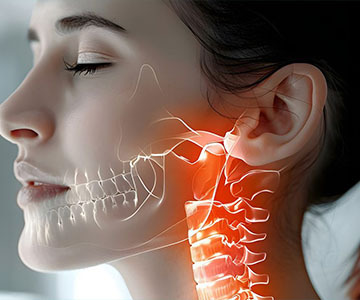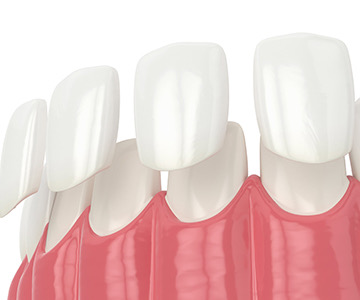Missing teeth are no longer a problem! Dental implants offer the most advanced, durable, and natural-looking solution for restoring your smile. An implant, together with its crown, mimics a real tooth both aesthetically and functionally-helping you regain confidence, comfort, and a complete smile.
To book a visit, sign up for a consultation. To clarify the details, our operator will contact you.

What Should We Know About Gnathology?
26 September 2024
Gnathology - is one of the modern fields of dentistry, which studies the relationship between the organs and tissues of the jaw and tooth systems, the norm, and many different pathologies. The science that studies the physiological characteristics of the jaw and tooth systems is closely related to all other fields of dentistry, be it orthodontics, prosthodontics, etc. The rules of Gnathology are taken into account in any type of dental treatment process. The main starting point of any occlusive reconstruction is gnathological treatment.
Any intervention in the oral cavity will be this treatment, if a long process of complex reconstruction of the jaw-teeth, should be carried out taking into account the individual characteristics of the patient's jaw and face. Improperly performed orthopedic, orthodontic, therapeutic or any other type of dental treatment can cause a number of problems in the area of the wrist and lower jaw joint. For example, problems may manifest as the following symptoms: pain in the jaw and upper face, a tingling sensation in the bones, stretching of the jaw muscle, restriction of the wide opening of the mouth, and a whistling sound in the ears. A gnathologist can quickly identify the underlying cause of the problem, restore oral harmony in the oral cavity, analyze all existing patient health problems according to cause-and-effect relationships, and suggest the most modern, optimal ways to treat pathologies. The goal of gnathology is to treat bruxism (an increase in the tone of the muscles involved in the movement of the lower jaw or hypertension, during which the hard tissue of the tooth (same enamel) wears out), to straighten the dentition or to restore the height of the tooth arch. Disappearance. The treatment lasts for 4 to 6 months, through special transparent caps, which are placed on the teeth of the lower jaw and are quite comfortable for the patient.
When To Start A Gnathological Treatment?
In patients in need of gnathological treatment, problems with organs and tissues of the jaw and tooth systems may present with many different symptoms. These may include stretching of the face and joints, restriction of mouth opening, wheezing in the ears, headache (in the morning), and pain in the groin and lower jaw. If the patient suffers from one or more of the symptoms listed below, gnathological treatment is necessary. It is necessary to plan a visit to the gnathologist to examine the patient's oral cavity and, if necessary, to take a diagnostic X-ray in the area of the joints.
How Is Gnathological Treatment Performed?
In the first stage of treatment, it is necessary to inform the patient as patients do not have direct information about this new field. სAfter the onset of symptoms, in addition to consulting a neurologist, maxillofacial surgeon or otolaryngologist, the patient should also consult a gnathologist. First, a 3D X-ray should be taken of the area of the mandibular joint and the flatness of the dental arch should be determined. 3D computed tomography is one of the main means of diagnosing gnathological patients. It provides a detailed discussion of both joints in millimeters. At the next stage, the gnathologist determines the individual treatment plan of the patient. Complete diagnosis, treatment planning, and dental manipulation performed to the maximum degree, both gnathological and other treatments, are the prerequisites for a healthy smile.
During pregnancy, hormonal changes can cause gum inflammation, bleeding, enamel erosion, and an increased risk of cavities. That’s why visiting the dentist during pregnancy is especially important.
Gnathology is one of the leading branches of 21st-century dentistry. It forms the foundation for any complex dental treatment planning
Tooth loss (edentulism) affects not only the appearance of your smile but also the overall functional health of your oral cavity
Dental veneers can be made from various materials, but ceramic (porcelain) veneers are the most widely used.
Modern aesthetic and functional dentistry is continually evolving, striving to identify restorative materials that combine exceptional strength
The eruption of baby teeth is one of the most important stages in a child’s early development.
Modern dentistry increasingly emphasizes the importance of orthodontic care.
Oral health care begins long before the first permanent tooth erupts.
A smile is one of the key elements of a person’s visual identity. It conveys confidence and positivity. However, the beauty of a smile is not only an aesthetic factor—it is directly connected to oral health.
Orthodontic treatment has long gone beyond the limits of traditional metal braces.
Dental implantation is the best method for restoring missing teeth. However, for the procedure to be successful, the jawbone must have sufficient volume and density.
Dental implantation is one of the most effective and safest surgical procedures in modern dentistry for restoring missing teeth.
Initial endodontic (root canal) treatment is usually successful and helps preserve the natural tooth.
Root canal treatment, also known as endodontic therapy, is one of the most frequently discussed yet often misunderstood dental procedures.
Tooth decay is one of the most common dental conditions, involving damage to the hard tissues of the teeth
Modern dentistry is constantly evolving, offering improved methods for solving complex issues.
Today, there are numerous teeth whitening options—both at home and professionally done.
Modern dental clinics are equipped with special equipment that ensures the safe use of anesthesia.
















.jpeg)

.jpeg)
